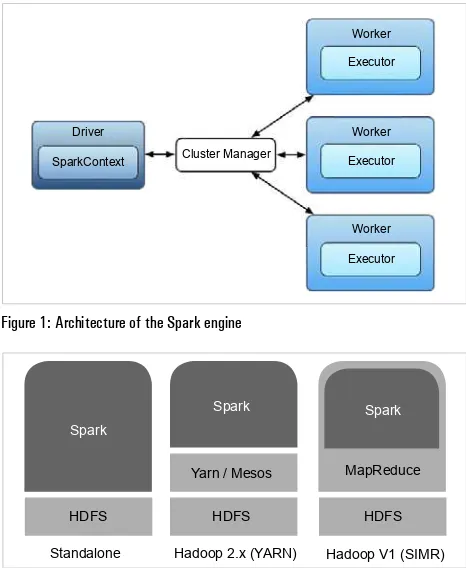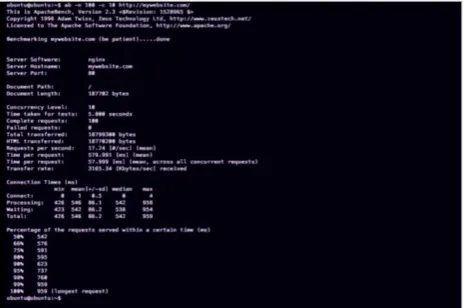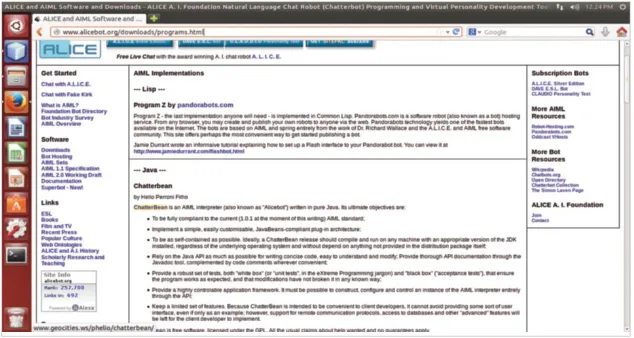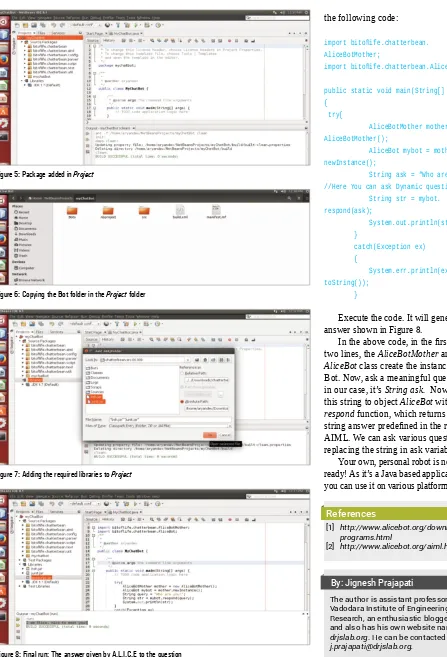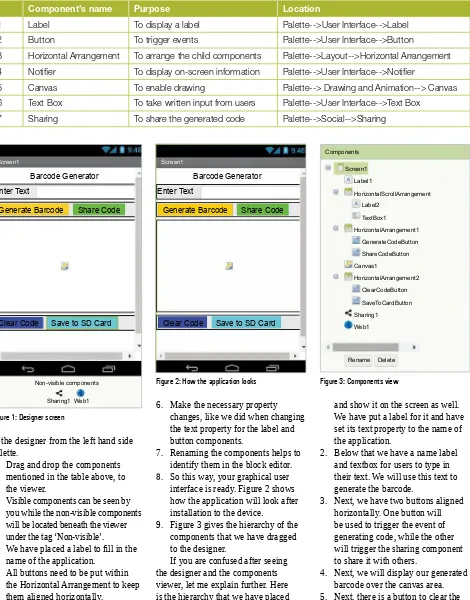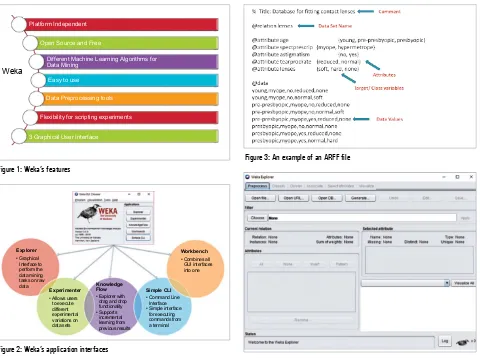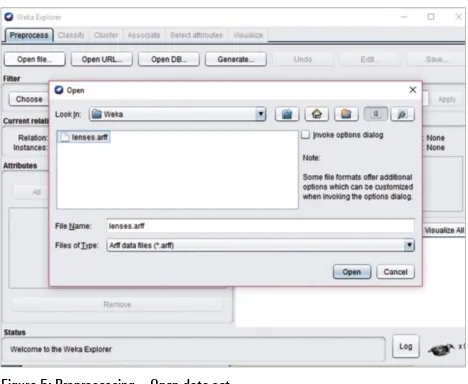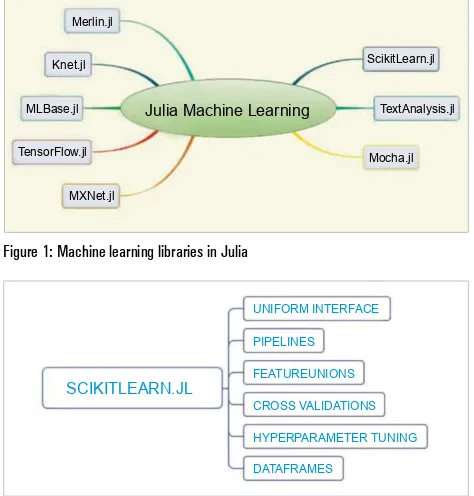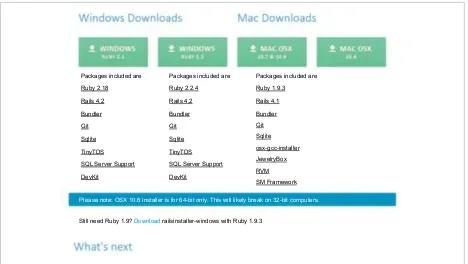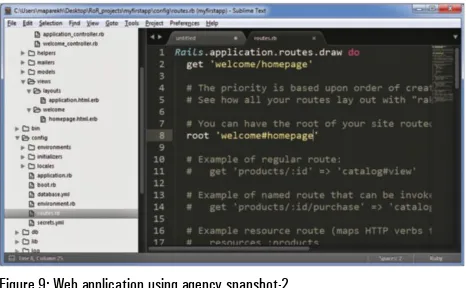Understanding
The Basics Of
Machine Learning
Accuracy
Intelligence
Artificial Neual Networks
Data Mining
Data Set
Accuracy
Intelligence
Artificial Neual Networks
Data Mining
Data Set
Online Analytical Association LearningDecision Tree Learning
Processing
Online Analytical
Volume: 05 | Issue: 03 | Pages: 108 | December 2016
An Interview With
Pradeep Chandru,
Founder And CEO,
Mafiree
Apache Spark: The Ultimate
Panacea For The Big Data Era
Why Ruby On Rails Should Be
A Developer’s First Language
An Introduction
To H2O
People Are Now
Even Doing Machine
Learning In JavaScript
Accuracy
Intelligence
Artificial Neual Networks
Data Mining
Data Set
Online AnalyticalAssociation LearningDecision Tree Learning Processing
Online Analytical
Post Show
Report
Machine
Learning:
The
Julia Approach
Improving The IQ Of
Computing SyStemS
—An Interview With Brendan Eich,
The Creator Of JavaScript
31 Apache Spark: The Ultimate
Panacea for the Big Data Era
39
Varnish: A Performance
Booster for Web Applications
Developers
41
REST API Development Using
Django Tastypie Framework
46
Create Your Own Java
Based Chat Robot
49 Creating a Barcode Generator
in App Inventor 2
52 An Introduction to Weka
55
Analysing Sentiments
with NLTK
57
An Introduction to
Google Machine
Learning APIs
61 Machine Learning: The
Julia Approach
64
Ruby on Rails: A Powerful
Open Source Web Framework
for Beginners
68
The Best Open Source
Machine Learning
Frameworks
72
AutoIt: An Open Source
Software Testing Tool for
Windows
77
Does Your Mobile App
Work Without an Internet
Connection?
82
An Introduction to H2O
and its Relation with Deep
Learning
89
regmap: Reducing the
Redundancy in Linux Code
Contents
R E G U L A R
F E AT U R E S
06 New Products
08 FOSSBytes
101 Editorial Calendar
Admin
102
Tips & Tricks
79
Applying Machine
Learning to Real
Business Problems
Post Show Report
Develop Real-time
Applications
with WebSockets and
Socket.IO,
Using Node.js
84
18
Not
Experience Linux in live mode.
DVD OF THE MONTH
• KNOPPIX 7.7.1
founder and CEO
of Mafiree
“People are now even
doing machine learning
in JavaScript”
Machine Learning Basics for
Newbies
FOR U & ME
93
A Few Tips on Vi/Vim
Editor for Linux Newbies
Columns
15
Exploring Software:
Programming with Objects
in Alice 3
29
CodeSport
EDITOR
RAHUL CHOPRA
EDITORIAL, SUBSCRIPTIONS & ADVERTISING
DELHI (HQ)
D-87/1, Okhla Industrial Area, Phase I, New Delhi 110020 Ph: (011) 26810602, 26810603; Fax: 26817563 E-mail: [email protected]
MISSING ISSUES
E-mail: [email protected]
BACK ISSUES
Kits ‘n’ Spares New Delhi 110020 Ph: (011) 26371661, 26371662 E-mail: [email protected] Ph: (022) 24950047, 24928520 E-mail: [email protected]
BENGALURU Ph: (080) 25260394, 25260023 E-mail: [email protected]
PUNE
Ph: 08800295610/ 09870682995 E-mail: [email protected]
GUJARAT Ph: (079) 61344948 E-mail: [email protected]
CHINA Power Pioneer Group Inc. Ph: (86 755) 83729797, (86) 13923802595 E-mail: [email protected]
JAPAN
Tandem Inc., Ph: 81-3-3541-4166 E-mail: [email protected]
SINGAPORE Publicitas Singapore Pte Ltd Ph: +65-6836 2272 E-mail: [email protected]
TAIWAN
J.K. Media, Ph: 886-2-87726780 ext. 10 E-mail: [email protected]
UNITED STATES E & Tech Media Ph: +1 860 536 6677 E-mail: [email protected]
Printed, published and owned by Ramesh Chopra. Printed at Tara Art Printers Pvt Ltd, A-46,47, Sec-5, Noida, on 28th of the previous month, and published from D-87/1, Okhla Industrial Area, Phase I, New Delhi 110020. Copyright © 2016. All articles in this issue, except for interviews, verbatim quotes, or unless otherwise explicitly mentioned, will be released under Creative Commons Attribution-NonCommercial 3.0 Unported License a month after the date of publication. Refer to http://creativecommons.org/licenses/by-nc/3.0/ for a copy of the licence. Although every effort is made to ensure accuracy, no responsi-bility whatsoever is taken for any loss due to publishing errors. Articles that cannot be used are returned to the authors if accompanied by a self-addressed and sufficiently stamped envelope. But no responsibility is taken for any loss or delay in returning the material. Disputes, if any, will be settled in a New Delhi court only.
SUBSCRIPTION RATES
Year Newstand Price You Pay Overseas (`) (`)
Five 7200 4320 —
Three 4320 3030 — One 1440 1150 US$ 120 Kindly add ` 50/- for outside Delhi cheques.
Please send payments only in favour of EFY Enterprises Pvt Ltd. Non-receipt of copies may be reported to [email protected]—do mention your subscription number.
Taiwanese memory and storage
manufacturer, ADATA Technology Co.,
has launched its HD700 hard drive,
which has a storage capacity of 1TB
and 2TB. The device is rugged and
easy-to-carry. Its silicone sheath cover
protects it from dust and moisture.
The device is designed with
cut-outs on the silicone cover to connect it
with a computer.
The thick rubber flap covers the
microUSB 3.0 port. The HD700 is
NEW
PRODUCTS
Rugged hard disk
from
ADATA
Harman International Industries,
a manufacturer of home and car
audio equipment, has launched two
Bluetooth speakers in India, namely,
JBL Clip 2 and Go+Play Mini.
The waterproof JBL Clip 2 is a
next-generation Bluetooth speaker that
comes with a high-quality, powerful
sound system and increased playback
time. The rugged device is designed
with a durable fabric casing along with
a smart carabineer that can be attached
with almost everything.
This easily portable device can be
used for any outdoor or indoor activity.
The Harman Kardon Go+Play Mini
is the smaller version of the previously
launched Go+Play.
It features wireless Bluetooth
streaming with dual sound and a
microphone conferencing system
for natural sound even in noisy
environments. The device comes with
a versatile stainless steel handle. It
has a built-in rechargeable battery
offering up to eight hours of non-stop
music. The device also works as a
power bank, as users can charge their
smartphones and other devices via the
USB charge port.
The Harman Kardon JBL Clip 2
and Go+Play Mini are available online
and at retail stores.
Address:
Harman India, Prestige
Technology Park, 4th Floor – Jupiter
(2A) Block, Marathahalli Ring Road,
Bengaluru 560103;
Ph:
+918043306300;
Fax:
+91 80 40976806
Two portable
Bluetooth
speakers
from
Harman
Price:
` 4,550
for 1TB
and
` 7,880 for 2TB
Multinational mobile hardware
company, BlackBerry, has
launched its latest smartphone in
India, the DTEK50. The device sports
a 13.2cm (5.2 inch) full HD (1080
x 1920 pixel) display with a pixel
density of 424ppi.
The single-SIM (micro-SIM)
device is powered by a 1.2GHz
octa-core Qualcomm Snapdragon 617 SoC.
It runs on Android 6.0.1 Marshmallow
and is coupled with 3GB of RAM.
The company claims the device is the
world’s most secure smartphone.
It comes with 16GB inbuilt storage
expandable up to 2TB via a microSD
card, and is powered by a 2610mAh
non-removable battery. The camera
features of the smartphone include a
13 megapixel rear camera with PDAF,
dual-tone LED flash with a 6-element
lens and an f/2.0 aperture.
It also has an 8 megapixel fixed
focus camera with an 84 degree wide
thicker than most external hard drives,
but is easily portable. It offers a transfer
speed of 5Gbps, which is the theoretical
limit of USB 3.0.
The ADATA HD700 is available in
blue and black, online and at retail stores.
Address:
ADATA Technology Co., 215
Atrium, Office No. 219, C Wing, 2nd
Floor, Andheri Kurla Road, Andheri
(East), Mumbai 400059;
Fax:
(022)
angle lens and an f/2.2 aperture.
The DTEK50 offers connectivity
options like 4G LTE, Wi-Fi 802.11ac,
FM radio, Bluetooth v4.2,
GPS/A-GPS and NFC. It also offers additional
features like an accelerometer, ambient
light sensor, gyroscope, magnetometer
and a proximity sensor.
The BlackBerry DTEK50 is
available online and at retail stores.
Address:
BlackBerry India, No-76,
Udyog Vihar 1, Gurugram, Haryana;
Ph:
+91-124-4648800
Price:
` 21,990
solar charging as well as regular
charging via AC power sockets and
has a rubber finish.
The power bank comes with a
single input port and dual output
USB port for charging two devices
simultaneously. It sports a 2.4W LED
panel light.
The water- and dust-proof device
is available in deep sky blue and lime
green colour options via online stores.
Address:
UIMI Technologies, F-16,
Sector-6, Noida, Uttar Pradesh
201301;
Ph:
91-120-4552102
Multi-feature
tablet
from
iBall
The prices, features and specifications are based on information provided to us, or as available on various websites and portals. OSFY cannot vouch for their accuracy.
Solar chargeable
power bank
from
UIMI
Compiled by: Aashima Sharma
Address:
Sony India, No-A-31,
Mohan Co-operative Industrial
Estate, Mathura Road, New Delhi –
110044;
Ph:
011-66006600
Address:
iBall, U-202, Third Floor,
Pillar No. 33, Near Radhu Palace, Laxmi
Nagar Metro, New Delhi – 110092;
Ph:
011-26388180
Japanese tech giant, Sony, has
launched another affordable
wireless headset in India, the
MDR-XB50BS. Perfect for
sports enthusiasts, the device
connects via Bluetooth and
NFC with up to 8.5 hours of
music playback time.
The IPX4 splash-proof device
enables users to keep the music
on even during a light drizzle.
It offers hands-free calling with
HD voice support via a built-in
microphone. The right side ear
piece of the Sony MDR-XB50BS
is designed with volume rocker
keys, which also act as the track
change button.
There is another
multi-function button that offers the
power on/off, play/pause and
call receive/reject features.
The Sony MDR-XB50BS is
available in black, blue and red
via online stores.
Consumer electronics company,
iBall, has launched its latest tablet,
the iBall Slide Brace X1, with
a number of new features. The
company claims this tablet is stronger
and faster than its predecessors.
It features a 25.5cm (10.1 inch)
capacitive multi-touch IPS display
with a resolution of 1280x800 pixels.
Powered by a 1.3GHz octa-core
ARM Cortex-A53 processor with
a MaliT720 GPU, the device offers
2GB of RAM. It runs on Android
6.0 Marshmallow out-of-the-box
and comes with inbuilt storage of
16GB, expandable up to 64GB using
a microSD card. The device features
connectivity options like 4G, VoLTE,
Wi-Fi, Bluetooth, micro-USB,
GPS/A-GPS, and OTG support.
The tablet is equipped with an 8
megapixel rear camera, auto-focus
with LED flash, along with a front
5 megapixel camera for selfies and
video calling. The device is preloaded
with a multi-language keyboard, which
supports 21 regional languages.
The Slide Brace XI comes with
a huge 7800mAh battery with up to
seven hours and 30 minutes video
playback on one charge. It has a thick
cylindrical stand at the bottom, which
allows the device to rotate and stand
upright on any surface.
The iBall Slide Brace X1 4G tablet
is available in ‘bronze gold’ online and
at retail stores.
Electronic devices manufacturer,
UIMI, has launched its 6000mAh
UIMI U3 power bank.
This is the company’s first power
bank to be made in India; it supports
Compiled by: Jagmeet Singh
OpenSUSE Tumbleweed gets
latest Flatpak framework
SUSE has announced a new update for OpenSUSE Tumbleweed that comes with
the most recent Flatpak framework. The newest version of Tumbleweed also
includes some other updated packages to deliver an enhanced experience.
To celebrate Halloween with developers, the OpenSUSE Tumbleweed
20161028 snapshot comes with Flatpak 0.6.13 to offer desktop applications on
the Linux environment. There is also OSTree 2016.12, which offers a layer for
deploying bootable file system trees and managing bootloader configurations.
The SUSE team has additionally included packages such as Mozilla Firefox
49.0.2 and Frameworks 5.27.0, along with new MIME type icons. The platform
also brings updates to openSUSE-specific packages, including YaST2-storage
3.1.105 and YaST2-http-server 3.2.1.
Apart from this, SUSE has released Tumbleweed snapshot 20161101 with
Hexchat 2.12.3, Wine 1.9.22 and Nimap 7.31. The four other versions after the
snapshot 20161028 have also received new treatments like some sub-packages for
AppArmors and dbus-1-glib, and Kiwi OS image builder version 7.04.8.
Developers can install the newest OpenSUSE Tumbleweed snapshot on their
systems immediately. It can be downloaded through the OpenSUSE factory.
Google ends support, development for Eclipse Android
Developer Tools (ADT)
Google has finally departed from the way in which it developed apps for its open
source platform by ending its support and stopping development work for the
Eclipse ADT. Instead, the search giant is now focusing on Android Studio, which
debuted as the official IDE for the Android
ecosystem back in May 2013.
The new development happened
following the arrival of Android
Studio 2.2.2 last month.
“There has never been a better time to
switch to Android Studio and experience
the improvements we’ve made to the
Android development workflow,” wrote
Jamal Eason, product manager for Android,
Google, in a blog post.
FOSSBYTES
US launches open source
repository, Code.gov
The US has finally taken a big step to
promote the open source world and
launched its Code.gov website. This move
is aimed at offering the code of the federal
government’s software to all the citizens.
This comes hot on the heels of the release
of the Federal Source Code Policy. The
online repository already includes nearly
50 open source projects from over 10
agencies. This would grow over time.
Also, the Barack Obama-led government
is set to provide tools and support to
agencies to implement its code policy.
“It is a step we took to help
federal agencies avoid duplicative
custom software purchases, and
promote innovation and cross-agency
collaboration. And it is a step we took
to enable the brightest minds inside and
outside of government to work together
to ensure that federal code is reliable and
effective,” wrote US chief information
officer, Tony Scott, in a blog post.
The administration believes that
Code.gov will become a ‘useful
resource’ for government bodies as well
as developers looking to build their
offerings on the government’s code. This
comes as an upgrade to the messaging
bot which Obama launched last month.
Apart from the US, open source is
influencing governments and authorities
all across the globe. Last month, Russia
showed it favoured open source software
by reducing its dependence on US
software vendors like Oracle, Microsoft
and IBM. The Indian government is also
in the process of launching a similar
repository in the near future.
FOSSBYTES
Future drones to get
powered by open source
Red Cat Propware, a young company
that builds software solutions for
unmanned aerial vehicles, has
launched its open source software and
services for the drone market. The
company has also established its new
headquarters at Humacao in Puerto
Rico to kickstart the development
of community-backed solutions for
advanced drones.
To introduce new features for
drones, Red Cat Propware is actively
working on building a strong open
source community. The company
is considering open source as an
opportunity for the fast-growing
drones market.
“Adoption of drones for
commercial and competitive racing
is exploding, pushing the limits of
the software and features,” said Jeff
Thompson, founder and CEO of Red
Cat Propware, in a statement.
Founded in 2016, Red Cat
Propware is offering not just software
but also support and training in the
drone market. The company also
provides custom drone applications
by leveraging the open source
community’s efforts.
Red Cat Propware is not the only
company that prefers open source
for the drone world. In August, Intel
introduced its drone controller that
offers an open source flight control
platform to developers. Canonical also
recently announced a development that
uses the Ubuntu platform to transform
drones into intelligent robots.
Google had originally announced the stopping of support and development for
the ADT in Eclipse in 2015. However, the latest Android Studio release helped the
company complete the awaited transition.
Android Studio 2.2.2 includes features like DDMS, Trace Viewer, Network
Monitor and CPU monitor to offer developers a close alternative to the Eclipse
tools. Additionally, the fresh Android Studio version comes preloaded with better
accessibility such as keyboard navigation enhancements and screen reader support
to enable people to develop Android apps easily.
Developers who would like to move their existing Eclipse ADT projects to
Android Studio just need to download its updated version and then go to the
built-in ‘Import Project’ menu option. Google has also opened its support to enable bug
filings and feature requests from the developer community.
Enthusiasts and open source contributors can go to the project page to access
Google’s code for Android developments.
CoreOS launches Operators to extend Kubernetes
with new capabilities
Linux distribution maker, CoreOS, has launched Operators as a new open source
container management concept. This is designed to extend Kubernetes and
simplify container management. The operating system is known for its capability
to maintain open source projects for Linux containers.
Operators is not standalone software from CoreOS. Instead, it depends
upon Google’s Kubernetes. The development works as a micro service to help
developers in breaking down a complex application structure into discrete pieces.
This improves the efficiency
of complex applications and
enables improved application
build delivery.
“An Operator builds upon
the basic Kubernetes resource
and controller concepts, and
adds a set of knowledge or
configuration that allows the
Operator to execute common
application tasks,” explained
Brandon Philips, CTO of
CoreOS, in a blog post.
In typical cases, the programmer has to first reduce the complex tasks on
a whiteboard to view the project, and then manually locate IP addresses of the
server and configure them on three different machines. Operators can automate
this process and save the developers’ time. The concept can reduce the effort
involved in all the manual work with one declarative statement.
Operators can even eliminate the layer of complexity of heavy scripting in
complex applications. It also makes it easy to enable periodical backups of the
application’s state and recover the previous state from the existing backups.
The CoreOS team has developed two open source Operators -- the etcd
Operator and Prometheus Operator. While the former enables developers to
create, manage and distribute etcd clusters, the latter provides a solution to use
with the Prometheus tool to monitor Kubernetes resources.
Developers can access the code of the etcd and Prometheus Operators
from their GitHub repositories. CoreOS is banking on the Kubernetes
community’s support for the new launch.
FOSSBYTES
Maru OS now comes with Android Marshmallow
Maru OS, which got open sourced earlier this year, has now been updated to version
0.3. The new update brings Android 6.0.1 Marshmallow to all virtual environments,
including desktops and mobile devices.
Originally running on Android 5.1 Lollipop, Maru OS now provides the
Marshmallow flavour. The arrival of the new Android platform on Maru OS
comes along with features such as improved power management, enhanced app
permissions and up-to-date security patches.
Apart from Android
Marshmallow, Maru OS v0.3
allows users to start the Maru
Desktop experience on a large
screen even without an HDMI
screen. Users just need to
enable Maru Desktop from the
dashboard to run the service in
the background. This helps if
the Maru OS-enabled phone is
yet to be plugged into an HDMI
display. Also, you can use SSH services if you have switched to the desktop mode.
For high-resolution displays with over a 1080p pixel-count, Maru OS now
comes with an ‘Enhanced resolution matching’ mode. This grabs the native
resolution of the connected display and overrides the device’s stock matching
algorithm. The updated version additionally includes several performance
improvements and bug fixes.
You can upgrade your existing Maru OS device to version 0.3 by following an
upgrading guide on GitHub. It is worth noting here that if you are about to install
the operating system for the first time and want to experience virtual environments
on Android, you need to have a Nexus 5.
Ubuntu Core 16 brings security closer to IoT devices
Security has been one of the significant concerns in the open source world over the
past several months. But now, Canonical has released Ubuntu Core 16 to ensure a
reliable and secure experience on Internet of Things (IoT) devices.
The latest Ubuntu Core is a compact
platform. Yet, it is capable of delivering what
the company claims is groundbreaking security
through confined, read-only Snap packages.
The operating system also comes with Update
Control to enable software publishers and
manufacturers to validate updates way before
they are applied to the devices. This helps in
reducing instances of vulnerabilities.
To offer transactional upgradability for the
entire platform, the operating system and kernel in Ubuntu Core are also delivered
as Snaps. Manufacturers can use the device-centric Snap app store on Ubuntu’s site
to let developers release updates throughout the device’s lifecycle, starting from beta
testing to general availability.
IoT device makers like Dell believe that the release of Ubuntu Core 16 will
enable them to offer long-term support and security on their offerings. This would
help them influence more customers to test their innovations.
AMD expands graphics
support for Ubuntu and Red
Hat Enterprise Linux
AMD has released the
AMDGPU-PRO 16.40 graphics driver with
support for Ubuntu and Red Hat
Enterprise Linux (RHEL). The
updated driver has emerged over
two months after the release of the
previous graphics driver, and is built
for various AMD Radeon R-series
GPUs.
The latest AMDGPU-PRO version
supports 64-bit Ubuntu 16.04 LTS
as well as RHEL 7.2. It also includes
support for APIs such as OpenGL 4.5
and GLX 1.4, OpenCL 1.2, Vulkan
1.0, VDPAU and Vulkan support for
DOTA2. Additionally, there is an
option to install script and Debian
packages for Ubuntu 16.04.
In addition to its support to an
expanding range of Linux operating
systems, the AMDGPU-PRO 16.40
driver includes support for AMD
Radeon R9 M485X, R7 M465, R7
M460, R7 M445 and R7 M440. The
updated driver also comes with FirePro
features such as EDID management
and 30-bit colour support.
AMD has acknowledged some
limitations alongside the upgraded
support on the new graphics driver.
It lags while producing graphics for
the ‘Company of Heroes 2’ game
and, on certain platforms, users are
unable to log in to the system after its
installation.
You can download the updated
AMD graphics by visiting its global
support website. The site also offers the
same driver package for RHEL 6.8.
FOSS
BYTES
HTML 5.1 is now the latest
Web standard
The World Wide Consortium (W3C)
has released the official HTML 5.1
specification. The new release is the
first minor revision of the fifth major
version of the Hypertext Markup
Language (HTML) that is being
widely used across Web apps.
“In this version, new features
continue to be introduced to help
Web application authors, new
elements continue to be introduced
based on research into prevailing
authoring practices, and special
attention continues to be given to
define clear conformance criteria for
user agents in an effort to improve
interoperability,” the W3C team
wrote in a blog post.
Unlike its previous version
that debuted in 2014, HTML 5.1
is not a big release. However, it
brings some new attributes and
elements such as srcset, <picture>,
<summary> and type=”context”.
The newest revision also comes with
the requestAnimationFrame API to
enhance Web animation effects.
Alongside the new additions, the
upgraded HTML standard includes
tweaks such as nested <header> and
<footer> elements, and the optional
url= attribute. The consortium has
removed some old features, like
media controllers and command API.
W3C plans to bring out the
HTML 5.2 recommendation
sometime in late 2017. In the
meantime, developers can start
testing the features of HTML 5.1.
“Dell has been working with Canonical on Ubuntu Core for over a year, and
our Dell Edge Gateways are fully-certified for Ubuntu Core 16. This enables
Dell to offer the long-term support and security that IoT use cases such as factory
and building automation demand,” said Jason Shepherd, director of strategy and
partnerships for IoT, Dell, in a statement.
Linux has so far been the first choice for IoT device manufacturers.
However, some serious issues emerged recently as warning against untested
deployments. The Mirai botnet surfaced in October this year, and exposed
thousands of connected devices to DDoS (distributed denial of service) attacks.
Most recently, NyaDrop emerged, which loads malware on hardware such as
DVRs and CCTV cameras.
Ubuntu Core is one of the popular solutions for devices ranging from
top-of-the-rack switches and industrial gateways, to radio access networks, digital
signages, robots and drones. Thus, its upgrade would bring enhancements onto a
variety of devices and enable refined security across the entire IoT ecosystem.
Alfresco Activiti 1.5 comes with extensive data modelling
Alfresco Software has released the Alfresco Activiti 1.5 business process
management (BPM) solution. The new update comes with extensive data
modelling features and
offers one-click access to
connected databases.
To improve Big Data
developments, Alfresco
Activiti 1.5 includes
support for external data
sources. Users can also
leverage the integrated enterprise content management (ECM) systems such as
Alfresco One to fulfil their data requirements. Additionally, there is an option to
‘persist’ the changing data on their records and even keep a changelog for the
underlying database.
“It is a basic tenet of our design philosophy that an inherently powerful,
full-featured but complex application must be made easy to architect by non-professional
developers. That is what we have accomplished with Alfresco Activiti 1.5 – allowing
developers of all levels to tap content to enrich existing or new business processes,”
said Paul Hampton, senior director of product marketing, Alfresco, in a statement.
The latest Alfresco Activiti includes integral content rule functions from
Alfresco One to allow users to develop automated rules that will alter content
under specific, pre-stated conditions. App developers can utilise content
management features on the Alfresco platform by using the flexible design of the
updated BPM tool. There is also a rich documentation functionality to let users
document the content and flow of business processes.
Analysts believe that Alfresco Activity is a ‘rising star’ in the IT market,
as it offers flexible design and many integration capabilities. “We are seeing
accelerating interest among enterprises to automate as many processes as feasible
– especially IT related processes, a trend that bodes well for both open source
and vendor sponsored business process engines,” stated Carl Lehmann, principal
analyst for enterprise architecture and process management at 451 Research.
Developers can access the advanced features of Alfresco Activiti 1.5
either on-premises or via a private cloud. It is available for a 30-day trial
through the official site.
FOSSBYTES
Microsoft open sources hyperscale cloud hardware design
Expanding its verticals to retain market leadership, Microsoft has open sourced
its next-generation hyperscale cloud hardware design. The new offering by the
Redmond giant is a part of the Open Compute Project (OCP) that was jointly
launched by Facebook, Google, Intel and Microsoft in 2014.
The design, called Project Olympus, is a new model for open source hardware
brought out by the
OCP community. It
applies an open source
collaboration model
that has already been
embraced for software,
which is completely
distinct from the current
process for open source
hardware developments.
“We are taking
a very different
approach by contributing our next generation cloud hardware designs when they
are approximately 50 per cent complete – much earlier in the cycle than any
previous OCP project,” wrote Kushagra Vaid, general manager, Azure Hardware
Infrastructure, in a blog post.
Microsoft is set to enable the community to contribute to its ecosystem by
downloading, modifying and forking the unfinished hardware design. This would
work similar to open source software.
Experts believe that this will help in bringing advancements to the existing
open source hardware development process. “Project Olympus, the re-imagined
collaboration model and the way they are bringing it to market is unprecedented in
the history of OCP and open source data centre hardware,” said Bill Carter, CTO of
Open Compute Project Foundation.
The initial designs of Project Olympus include a new universal motherboard,
a high-availability power supply and a battery. To fulfil global data centre needs,
there is a 1U/2U server chassis, high-density storage expansion, universal rack
power distribution unit (PDU) for global data centre interoperability and a
standards-compliant rack management card. These modular blocks will be available
independently, subject to requirements.
“We believe Project Olympus is the most modular and flexible cloud hardware
design in the data centre industry. We intend for it to become the foundation
for a broad ecosystem of compliant hardware products developed by the OCP
community,” Vaid added.
Microsoft has released the motherboard and PDU specifications of the project
on the OCP GitHub branch. Also, the entire rack system will soon be available as
open source hardware.
Microsoft is not the lone player in the emerging world of open source hardware.
Facebook is also actively developing its latest telecom and networking solutions for
the community. These developments are predicted to get bigger over time.
Facebook develops open source networking infrastructure
Facebook has extended its Telecom Infra Project (TIP) and developed a new
transponder platform called Voyager to deliver a scalable and cost-effective
infrastructure solution. The new device is based on packet-optical technologies to
enhance bandwidth delivery with cost-efficiency and customisability.
FOSS
BYTES
The very first version of Voyager is designed to leverage data centre
technologies that were
debuted with the
top-of-the-rack switch, Wedge
100. It has a switch ASIC to
aggregate the 100 GbE client
signals. Additionally, there
is the DSP ASIC and the
optics module (AC400) from
Acacia Communications
to deliver an upgraded
networking solution in the
market.
Facebook’s team has used the open line system that includes Yang software
data models and an open northbound software interface to enable scalability on
the new hardware infrastructure. The social networking giant has partnered with
Snaproute for the software architecture of the end-to-end solution.
“An open approach allows any vendor to contribute new hardware and
software to the system. In the beginning, the open line system will include Yang
software data models of each component in the system, and an open northbound
software interface (NETCONF and Thrift) to the control plane software,”
Facebook engineers Ilya Lyubomirsky, Brian Taylor and Hans-Juergen Wolfgang
Schmidtke explained in a blog post.
Facebook has provided a hardware management daemon-based network
element software stack with Voyager. The daemons enable configuration,
management and monitoring of the hardware layer and provide services like
higher-layer software to allow the provisioning of the hardware. Also, a
multi-language SDK layer is available to enable third-party app development on the
advanced infrastructure.
Facebook has already tested how Voyager operates in field trials with Equinix
in the US and MTN in South Africa. The company is also aiming to release the
code of the Voyager software to enhance its platform.
The development of an optical fibre-supported transponder like Voyager will
certainly upgrade the present networking field. Besides, the open source approach
will help Facebook to quickly grab attention from not just telecom operators but
also several developers and data centre providers around the globe.
Ubuntu gets ‘Budgie’ flavour
Linux distribution Budgie-remix has transformed into a new Ubuntu flavour. With
this development, the open source build is now available as ‘Ubuntu Budgie’.
The team behind the platform confirms that the Ubuntu Developer
Membership Board has passed Budgie as the official Ubuntu flavour after
reviewing its technical aspects. For users, the transformation will bring
community standards to the distribution.
“We have come a long way in
a short time with our first 16.04
release — a major update at 16.04.1
as well as following and taking an
active part with the Ubuntu release
cadence for 16.10,” the Budgie
team wrote in the announcement
statement.
Amazon Linux container
image now available for
on-premise data centres
Amazon has released the Amazon
Linux container image for on-premise
data centres. This new release enables
Amazon Web Services (AWS) clients
to deploy the same customised Linux
experience on their own servers,
which previously were limited to
virtual machine instances by the
e-commerce giant.
In addition to its on-premise
presence, the Amazon Linux image
can be deployed on the cloud. It is
available through the EC2 Container
Registry and built using the same
code and packages that were initially
available within the Amazon Linux
AMI, which offers a ‘stable, secure
and high-performance’ execution
environment on AWS.
“Many of our customers have
asked us to make this Linux image
available for use on-premises, often as
part of their development and testing
workloads,” AWS chief evangelist Jeff
Barr wrote in a blog post.
The Amazon Linux image is not
the only open source distribution
available for AWS data centres.
CentOS, CoreOS and even Red Hat
Enterprise Linux and Canonical’s
Ubuntu are compatible with the
on-premise data centres. However, the
newest image is designed to use EC2
and limited remote access, with no
root login and mandatory SSH key
pairs to deliver a security profile.
It also supports container solutions
like Docker to enable advanced
developments.
FOSS
BYTES
For more news, visit www.opensourceforu.com
In addition to standards, there will be a new Ubuntu
Budgie community to enhance the operating system.
Developers will also get a chance to use help sites like Ask
Ubuntu, Ubuntu Forums or Launchpad.net to easily ask for
support on the latest platform.
Moving from just being another Linux distribution to an
official Ubuntu flavour was not an easy task for the Budgie
team. In fact, this massive task required several software
changes, packaging updates, merging updates upstream and
testing the results.
The official Ubuntu Budgie release will be available
with the 17.04 release. There are also plans to add
Budgie-desktop 11.
Ninety-eight per cent of developers use open
source at work
Open source scales new heights each day. But a new study
that surfaced online claims over 98 per cent of developers
use open source tools at work.
Git repository manager GitLab has conducted a
survey that revealed some interesting facts about open
source adoption. The survey, conducted with a developer
group, claimed that of the 98 per cent of developers who
prefer open source usage at work, 91 per cent opt for the
same development tools for work and personal projects.
Moreover, 92 per cent of the group consider distributed
version control systems (Git repositories) as crucial for their
everyday work.
Among all the preferred programming languages,
JavaScript comes out on top with 51 per cent of respondents.
It is followed by Python, PHP, Java, Swift and Objective-C.
Also, 86 per cent of developers feel security is a prime factor
for judging the code.
“While process-driven development techniques have
been successful in the past, developers are searching for a
more natural evolution of software development that fosters
collaboration and information-sharing across the life cycle
of a project,” said Sid Sijbrandij, CEO and co-founder of
GitLab, in a statement.
GitLab surveyed 362 startup and enterprise CTOs,
developers and DevOps professionals who used its repository
platform between July 6 and July 27, 2016.
Linux Foundation now manages the
JavaScript community
The Linux Foundation has announced the transition of
the original JQuery Foundation into the JS Foundation
to support a vast variety of JavaScript projects. This new
collaboration will help the JavaScript community under the
new mentorship programme.
In addition to the
Linux Foundation,
the JS Foundation
has founding
members such
as IBM, Ripple,
Samsung, Sense
Tecnic Systems,
SitePen and the
University of Westminster, among others. The objective of the
new group is to ‘drive broad adoption’ as well as support the
ongoing development of JavaScript solutions and ‘facilitate
collaboration’ within the developer community.
“The JS Foundation aims to support a vast array of
technologies that complement projects throughout the entire
JavaScript ecosystem,” said Kris Borchers, executive director,
JS Foundation, in a statement. “We welcome any projects,
organisations or developers looking to help bolster the
JavaScript community and inspire the next wave of growth for
application development,” he added.
The JS Foundation is not only set to focus on mentoring
projects on the client side but also on the server side. Target
areas of the JavaScript-centric group will revolve around
application libraries, mobile application testing frameworks,
JavaScript engines and ecosystem technologies.
The list of the initial projects under the JS Foundation
Mentorship includes the Appium testing automation
framework, the JerryScript JavaScript engine, the Mocha
testing framework, Moment.js date library and the Node-RED
programming environment. These initiatives will now operate
in a community-driven environment.
The Linux Foundation is set to develop an open and
technical governance model that includes a technical advisory
committee and a governing board with representatives from
member organisations. The group will work with standards
bodies like W3C, WHATWG and ECMA TC39. Additionally,
the Node.js Foundation will work closely with the group to
select various open source projects.
Guest Column
Exploring Software
www.OpenSourceForU.com | OPEN SOURCE FOR YOU | dECEmbER 2016 | 15
In this article, the author, who likes to explore different kinds of
software, introduces readers to Alice 3 and indicates how to go about
installing it as well as create games and stories with it.
Programming with
Objects
in Alice 3
M
y first exposure to the Alice learning environment was when I listened to the remarkable Randy Pausch’s Last Lecture, http://www.cmu.edu/randyslecture/. Alice has been on my list of software to explore for years now, and I finally got around to doing that after exploring Scratch.Like Scratch, there is a stage, or rather, a 3D world, in Alice. You populate your world with objects and then program the objects to do what you want. As with Scratch, it is an excellent way to tell stories or create interactive games. Alice is more complex than Scratch as there is one additional dimension, and a special object—the camera. You view the world through the camera, which you may also program.
You can download Alice 3 from alice.org. Note that it is almost 1.5 GB! The reason for the large download size is that it comes with a large gallery of artwork, which made it possible even for me, who has trouble drawing stick figures, to experiment with 3D animation.
A programmer’s perspective
As a programmer, the first thing you may notice when you start Alice 3 is the keyword, this! The connection to Java is obvious.
When you set up the scene to add the objects you want, you will notice that you can browse the gallery by Class Hierarchy. The classes include:
Biped: Adult, teen, alien, rakshasa, skeleton, etc Flyer: Chicken, peacock, penguin, etc
Swimmer: Fish classes, marine mammal classes, etc In the Edit Code mode, you can browse the procedures and functions associated with each object in your scene.
Chances are that a non-programmer may not even notice the above!
Getting started
A non-programmer is more likely to browse the gallery by themes, e.g., Africa, Amazon, fantasy, ocean, wonderland, etc. Choosing wonderland will allow you to create objects like Alice, Mad Hatter, Mushroom, and so on.
The best way to learn is to follow some video tutorials. You can find a set of these from Duke University, https://goo.gl/nYWpY4. The beginner’s tutorial, Witch’s Cauldron, consists of seven videos, each lasting only four to five minutes. It is an excellent way to acquire an understanding of how to use Alice 3.
You will learn to:
Create a world and add objects to it Position, orient and resize an object Position and orient the camera Code the actions of various objects
Creating a simple game
The next tutorial to try is how to create a simple game—the UFO Alien Rescue game — at the ICE Distance Learning Site, https:// goo.gl/vlRKRF.
Here, you will learn more about creating objects and changing their properties.
On the programming side, you will learn how to control the game flow using the arrow keys and the space bar to move the spaceship over the aliens, and how to pick up each one. The programming constructs needed are the usual Conditional Statements, Creating and Using Variables, Handling Events, and Creating Procedures and Adding Parameters.
Alice 3 makes it easy to program a game like this one with functions like isCollidingWith to test if a beam has located an alien. You can set the opacity of the beam so that the aliens continue to be visible even if surrounded by the beam. You can then use the moveTo method to move an alien to the UFO, and set the vehicle of the alien to the UFO so that both move together.
Telling a story
Entertainment will continue to be what people need, even if robots do all the work. Apart from sports and games, the other major entertainment for all of us is story-telling. Hence, the final tutorial you should try is creating a trailer for ‘Finding Nemo’ from an Alice 3 workshop, https://goo.gl/BAWBQy.
The story you will tell in this case is:
Create a 5-10 second animation that shows Marlin’s (a small fish) frightened reaction on meeting a shark.
As SharkEncounter.a3p does not seem to be available for download, you can create a new project using the sea floor. Add Marlin (ClownFish), Dory (BlueTang), a shark and a treasure chest from the gallery of the Ocean theme. You can now follow the tutorial.
Considerable time and effort will be spent in setting up the scene. Programming is easy once the scene is set up. Animations rely upon the duration option to indicate how long a particular step should last. It is fun to play around with Alice 3 and you are now ready to create your own stories!
The author has earned the right to do what interests him. You can find him online at http://sethanil.com, http://sethanil. blogspot.com, and reach him via email at [email protected].
By: Dr Anil Seth
Services To Assess, Manage, Customise
And Deploy,
All Under One Roof
Lyra Infosystems: Enabling IT evolution
Deploying open source technologies is not an easy task. But
there are certain companies that make the deployment seem
like a breeze, by delivering effective and efficient results –
offering a range of services under one roof. Bengaluru based
Lyra Infosystems is one such concern, which has a vision of
becoming a globally recognised, innovative, dedicated and
productive IT consultant firm. Specialised in professional
services and consulting, the company offers widespread
support and comprehensive consultation for all open source
technologies and deployment. These state-of-the-art services
have been offered to its clients since the last decade.
Lyra offers implementation tools, upgrades, security
and vulnerability resolution services to clients. It is also
specialised in DevOps & ARA, RSM, SCM and information
management services. With superior industry experience,
Lyra’s team has been proficiently providing cutting-edge
solutions covering all the activities around OSS (open
source support) services. It provides security, training and
consultation, as well as legal remediation and other services.
The road to success
Rohit Sharma established Lyra in early 2007. Prior to this
venture, Sharma worked in companies like SDRC (India),
ISI (Integrated Systems Inc), Wind River Systems and
PixTel Communications. With more than two decades of
sales, marketing, operations and management experience,
he has also been part of a couple of startups as a founding
member, and helped establish them as successful and
stable organisations. At Lyra, Sharma is responsible for
sales and operations.
Distinguishing itself from the competition
Leveraging the first-mover’s advantage, Lyra enjoys
technological leadership because of its distinctive services. It
is not only the first in the segment but also presently the only
such firm in the Indian market. Lyra now enjoys good brand
recognition, having been through a long learning curve that
has led to more secure and efficient means of delivering its
services and solutions.
To accelerate and design services and solutions in an
innovative way, Lyra has strengthened its R&D team. It has
senior management teams across all verticals, including
sales, marketing, legal and IT, that help to pursue strategic
alliances with the pioneers of DevOps, SCM and RSM.
Also, it has plans to reach overseas markets and grow
in new market segments.
Challenges faced during the journey to success
Being the first-mover, Lyra inevitably faced several
challenges in creating and marketing the new services and
solutions it offered. Apart from some financial challenges,
Lyra was confronted with some other hurdles like the need
for gap fixing while introducing a new solution in the region.
The company has spent years to build awareness about its
revolutionised solutions.
Amongst other challenges, research emerged as one of the
biggest for Lyra. Gathering primary and secondary data to back
certain assumptions on business projections was the key behind
the issue. The company also faced difficulties in finding reliable
partners. To reap the maximum benefits out of a partnership,
Lyra looked for organisations that were pioneers in their
segment and had a good reputation amongst industry giants.
The benefits for clients
Lyra’s distinctive services and solutions are used across the
ASEAN region. Its clients have seen several operational
and financial gains such as reduced overheads and
optimum efficiency.
To reduce business risks, Lyra protects corporate IP
and assists with compliance reporting. It also enables the
implementation of a repeatable business process to support
corporate compliance policies and gives deep insights
into projects including known vulnerabilities, licence
requirements and project activity. Additionally, it alerts
companies when any new vulnerabilities are identified
for their projects, and helps them manage and track
remediation activities.
For enhanced security, Lyra adds an extra layer of online
and network security. With its expertise in privileged access
and password management, Lyra assists in incorporating
privileged session management with a secure password vault
that ensures privileged account passwords are protected.
Going forward with open source
An open source industry survey shows that 56 per cent of
corporations contributed to open source projects a couple of
years back. At present, the world is witnessing the next wave
of open source. Companies like Twitter, Facebook, Netflix
and Ericsson are participating in the OSS community, and
developing and using open source in their own frameworks.
All in all, open source is the future of technology. Lyra’s
pioneering experience and expertise in the open source
domain will definitely assist its clients with the adoption and
correct usage of open source.
Advertorial
With businesses striving to gain a larger share of the market, there is a pressing need to stay ahead of the game. At Lyra, we provide solutions that translate into competitive advantage. With more and more businesses moving towards the open source system, we
ensure that you are at the forefront of the next wave in enterprise software.
Lyra Infosystems Pvt. Ltd.
,
#149, 3 floor, 1 Block Koramangala, Bangalore - 560034, Karnataka, India
Open Source India 2016
Open Source India (OSI) just hosted its 13th edition this year. The iconic convention
had sessions by over 60 speakers. The 10 workshops held at this event were attended
by a large number of open source supporters from India and around the globe. Apart
from the expert talks, OSI also became a place for exhibitors to showcase their various
community-centric offerings to hundreds of attendees.
T
he EFY Group hosted Open Source India 2016 on October 21-22 at the NIMHANS Convention Centre in Bengaluru. The event was attended by various technology enthusiasts who were anxious to know more about what’s new in the world of open source.“The event was well planned in terms of the separate tracks for informative presentations and technical workshops,” said Debabrata Nayak, project director—open source collaboration, National e-Governance Division.
Nayak was one of the prominent faces at this year’s Open Source India and a key speaker, from a list that included Balaji Kesavaraj from Microsoft, Bruno Lowagie of iText Software, Andrew Aitken of Wipro and Virendra Gupta of Huawei India.
“There was a lot of interest among visitors for iText. Many people who attended my talk had some great questions and several high-quality candidates even applied for our openings in India,” stated Lowagie, who is the founder of iText Software.
Attendees who were quite excited to learn about the latest open source developments at the event included developers, IT managers and CIOs, among others. Apart from the professionals, the convention was well attended by many evangelists and entrepreneurs.
“Open Source India 2016 offered the right balance of content, which focused on sharing technical knowledge as well as the trends in open source adoption at the enterprise,” said Monojit Basu, founder of TechYugaddi.
All trends under one roof
Open Source India 2016 featured talks on trending topics such as the cloud and Big Data, IoT, Web and mobile app development, and databases. It also kept audiences engaged with the inspiring back-to-back sessions at the Success Story track. CIOs and IT heads hosted some thought-provoking and engaging discussions throughout the two days of the event.
Open Source India 2016
“We are glad to have presented DigiLocker as an open source success story from within the government, at such a platform. We are really overwhelmed and excited with the response of the open source community to our story, at the event,” Nayak told Open Source For You.
First-hand experience for techies
In addition to the technology sessions, the event featured hands-on workshops hands-on open source hardware, software architecture, Web application security, Docker, DevOps and Data Lake as well as a whole-day OpenStack India conference. The convention also included a panel discussion on cyber security, dubbed as ‘Advanced cyber attack vectors using Web-based systems’.
Experts’ panel discussing cyber security practices
“The cyber security panel discussion at Open Source India provided an opportunity for the audience to get some first-hand, real-time experience on how real hackers analyse and mitigate the APT risks,” said Divyanshu Verma, engineering manager, Ericsson R&D who hosted the discussion at a packed hall.
Companies and government bodies joined together
Leading technology companies such as Microsoft, Fiorano Software, iText Software, Wipro, Mafiree, Huawei, Lyra Infosystems, Citrix, 2ndQuadrant, Siemens, Ashnik, Cloud Enabled, Asttecs and Zoho participated at the convention to support the growth of open source in the country. Also, the Indian government backed the initiative through the participation of its National e-Governance Division.
“We are delighted to have hosted another incredible edition of Open Source India this year. It was far bigger and more exciting than our expectations,” commented Ramesh Chopra, executive chairman, EFY Group.
Real-time updates from the convention were posted directly on Facebook and Twitter. Also, the inaugural sessions of the event were broadcast live to the world.
“We hope that the trend of supporting open source in India will continue in the future and that Open Source India will become the first choice for worldwide industry professionals as well as young developers and enthusiasts,” Chopra concluded.
Open Source India 2016
Balaji Kesavaraj, director of platform strategy and marketing, Microsoft India
“Open Source India has become one of the most exciting gatherings for the open source world. This year’s edition covered all the major technology trends, and Microsoft Azure was among the top hits at the convention. We saw that a huge number of attendees were keen to get their first impression of our open public cloud platform – Azure. They also got an opportunity to get hands-on, while working with open source technologies on Azure.”
Tony Van den Zegel, director of sales, iText Software “The organisation of the event was excellent. Also, the attendees showed lots of interest, came on time and stayed till the last sessions. I have witnessed different situations in the past, in India.”
Ajay Bidari, VP, Cloud Enabled
“Indeed, it was great to be at Open Source India. We have received superb leads and exceptional
support from the entire EFY team, which made us feel proud to be at such a highly organised edition.”
Chanchal Bose, CTO, Prodevans Technologies
“Open Source India has emerged as a platform for people to communicate with experts who are already engaged in open source developments. It has become a great place to get training related to various software and hardware. Additionally, we got an opportunity to know what the computing world demands from a solutions provider like us. It has been a very exciting experience.”
Dr Devasia Kurian, MD, Asttecs “It is a great feeling to be here and quite interesting to see how the event has
developed over the years. Today, several of the big guys are here— Microsoft, Citrix and some other tech giants who are interested in supporting open source. Also, the talks at the convention were done by some of the industry’s prominent speakers. The event has also attracted companies that are into the proprietary business but are embracing open source. Overall, I would like to express my appreciation to the whole Open Source India team.”
Sandeep Khuperkar, MD, Ashnik India
“It was a pleasure attending Open Source India. This is a platform where the community can meet the industry and enterprises, while the industry can understand better how technologies in the open source world can be used in the mainstream. Likewise, the industry feedback through the event helps the open source community to know the best ways to participate further, to bring these technologies into the mainstream. The event was also very well arranged, and sessions were well-timed; I did not see any delays. All in all, the EFY Group conducted the event quite well. I look forward to continuing to participate in Open Source India in the coming years.”
Suresh Govindachetty, lead sales engineer, Citrix Systems India “The event was well organised and the people who attended the event evinced lots of interest in exploring the technologies we displayed. The support staff was helpful and guided us when needed.”
Ankit Panchari, technology evangelist, Zoho
“This was the first time we participated in Open Source India. It was a wonderful experience to have interactions with the developer community here. The sessions were quite informative. Since we were aiming to reach the developer community through the convention, we met the right people. Overall, everything at the event was good.”
Asheem Enoch Bakhtawar, regional director for India, 2ndQuadrant
“I really enjoyed this event, especially our lead generation, which went quite well. In fact, there were certain leads that I would never have gotten. It was very motivating for us to be able to
reach out to the people whom we dreamt of meeting. At the same time, it gave us the opportunity to meet the open source community at one place. I am very grateful to EFY for hosting this convention.”
Krishna M. Kumar, lead architect and delivery head for cloud and PaaS, Huawei Technologies
“I have been associated with Open Source India since the last three to four years. Thus, I can say that it has been improving every year. I felt the audience has grown and the quality of the sessions this year was much enhanced. There were several international speakers like Andrew Aitken and Bruno Lowagie, sharing their in-depth knowledge about the open source world.”
Nityananda Panda, manager-training and consulting, Coss
Open source has now become the foundation of emerging technologies like OpenStack, Hadoop, Puppet, Docker and Ansible among others. Prodevans, our software solution and support wing and leading Red Hat solution partner, has also made its strong presence in the deployment and support world using open source and DevOps offerings.The Open Source India platform facilitates one-on-one interaction with the industry experts from the various field of specialisation and helps us keep in sync with emerging technologies. The event has emerged as an excellent opportunity to interact with the industry experts as well as the core community members at the same place.
Rahul Singh, marketing manager, Lyra Infosystems
“It was indeed a pleasure to be part of Open Source India. The event was professionally managed. Speakers and panellists were carefully chosen. The topics were very relevant and sessions were highly participative. The event was a great success for our team. We had the opportunity of meeting the extremely receptive (target) audience. The OSI team was very accommodating and helpful.”
Delegates praise
Balaji Kesavaraj, director of platform strategy and marketing, Microsoft India, detailing
